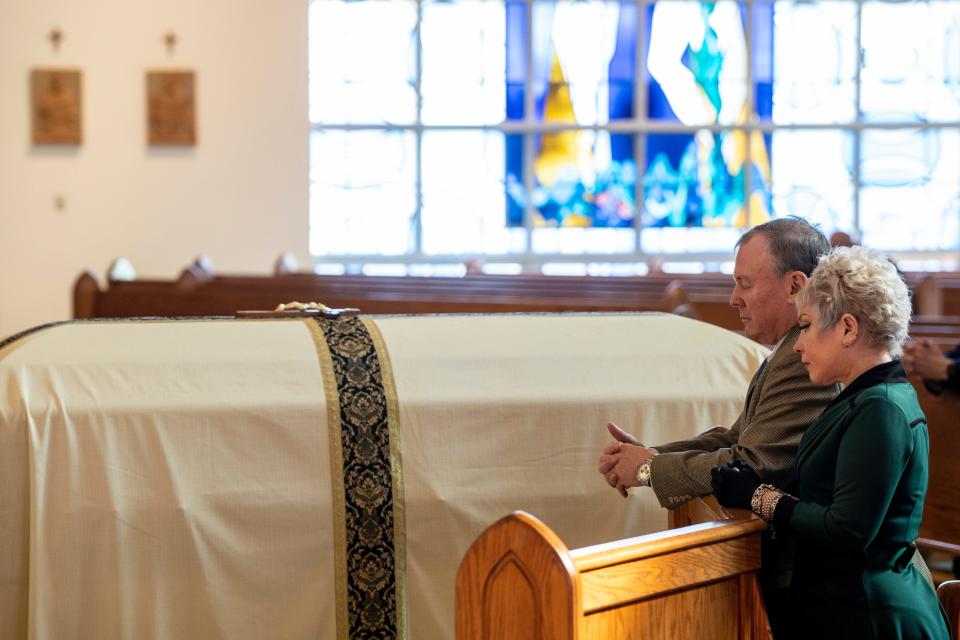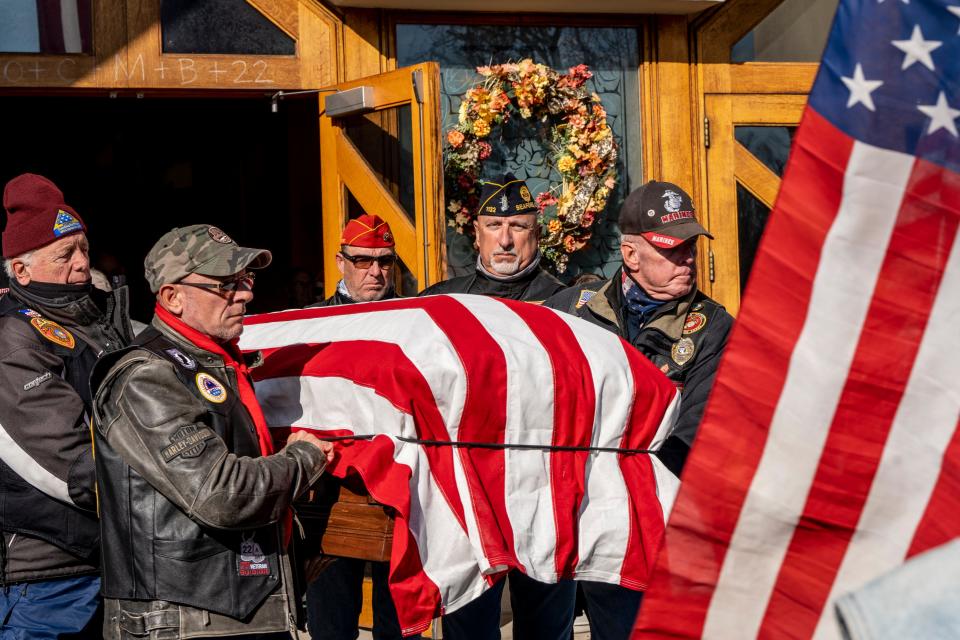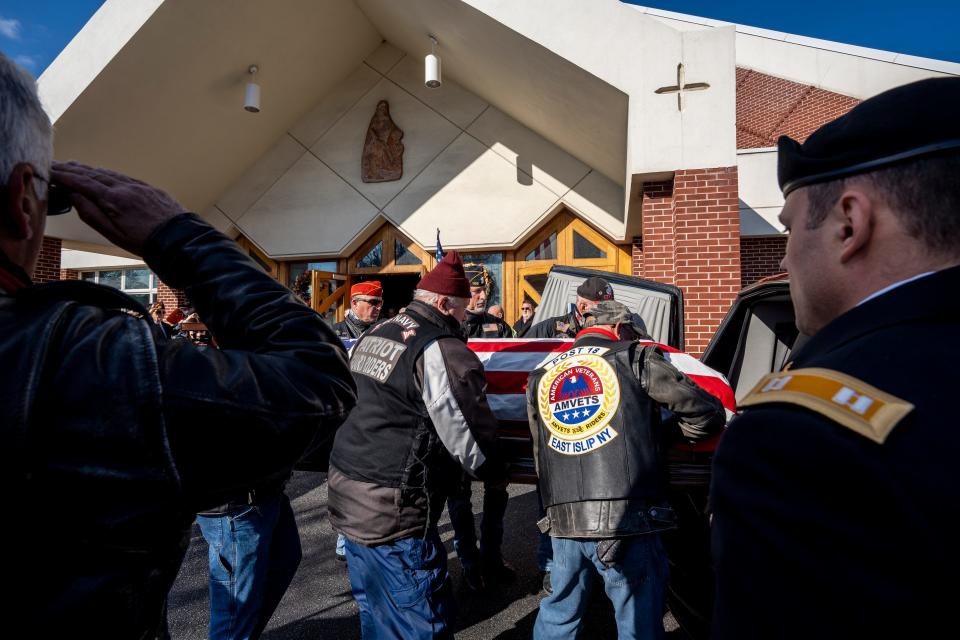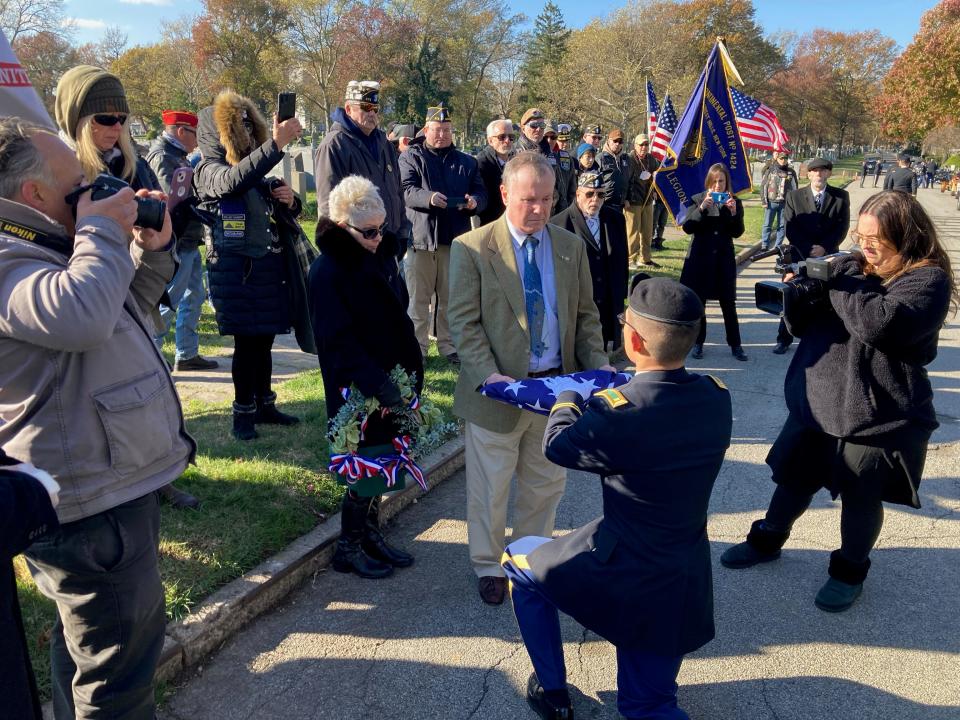The final journey home: John J. Heffernan is laid to rest after 8 decades | Mike Kelly
John Heffernan finally returned to his mother's side on Saturday.
It’s been nearly 80 years.
Heffernan, a U.S. Army Air Corps lieutenant and navigator who dreamed of becoming a doctor if he survived World War II, was killed in Burma in February 1944 when his B25G bomber was shot down by Japanese forces. He was just 24.
On Saturday, his remains — five teeth, a five-inch sliver of shoulder bone and skull fragments recovered in a peanut field in Burma last year and identified through DNA technology — were buried in a poplar coffin under a maple tree at a Queens cemetery, next to the grave of his mother, Mary.

How Heffernan came to be laid to rest in his family’s plot at St. John’s Cemetery in Queens after a funeral at St. Elizabeth of Hungary Church in Wyckoff — and a police-led caravan that shut down Routes 208 and 4 in New Jersey, along with the upper level of the George Washington Bridge, then the Harlem River Drive, the RFK Bridge and, finally, Woodhaven Boulevard in Queens — is a story of motherly perseverance and luck that took eight decades to unfold.
It was Mary Heffernan, a math teacher from Brooklyn, who pleaded with a wide range of officials for help in finding her son’s remains after World War II. She died in 1963, her wish unfilled, as Burma, beset with the volatile politics of the Cold War, barred U.S. search teams for decades from finding missing soldiers.
Two years ago, a special team of Pentagon investigators and anthropologists located the site of the crash of Heffernan’s bomber in Burma, now known as Myanmar. But they found only bone fragments.
Thanks to DNA supplied by Heffernan’s nephew, Andrew McVeigh, of Oakland, who never met his uncle, Heffernan’s remains were identified and brought back to America and a grave next to his mother.
“This is a very unusual circumstance,” said McVeigh, 72, a retired financial planner, in eulogizing his uncle at the end of a funeral Mass at St. Elizabeth of Hungary. “I’m the chief mourner at a funeral for a man I’ve never met.”
As he prepared the funeral and reviewed Mary’s letters, McVeigh said he came to deeply admire his uncle, then on his third tour as a bomber navigator when he was killed.
“The thing that has struck me most about him is he had to realize on the third tour that the odds of his survival were almost miniscule,” McVeigh said.
The story of finding Heffernan’s remains was recounted exclusively last month by Northjersy.com and the USA TODAY Network.
When Heffernan perished in his navigator’s seat aboard the 19,480-pound B-25G with six other crew members and his body was not recovered, it left a deep wound in the family that remained open for generations, a painful reminder of the perils of war.
McVeigh said the family often spoke of his uncle at holidays. “He was the golden boy,” McVeigh said.
Earlier this week:World War II hero John J. Heffernan arrives back in the US for a final farewell
Mike Kelly exclusive:Exclusive: After eight decades, a lost soldier finally returns home — Mike Kelly
Heffernan’s mother reached out to the Pentagon, to Congress — even to a Roman Catholic bishop in Burma — asking for help in retrieving her son’s body. But help was either non-existent, misguided by bureaucracy or delayed by the volatile politics of Burma.
Another problem was that the crash site, where Heffernan died, was often flooded with silt from a nearby river. Heffernan’s remains were located under 10 feet of mud. None of the other crew members' remains have been identified.
“This was a huge tragedy for the family,” said McVeigh. “It was like something was missing for all of our gatherings. He was always a mythical person in my life. But he wasn’t there. There was a huge void."
Saturday’s funeral and burial, while somber, was somewhat celebratory. One of America’s 80,000 soldiers who have not been accounted for after World War I, World War II and the Korean and Vietnam conflicts, was finally home.

The Rev. Stephen Fichter, pastor of St. Elizabeth’s, praised Mary Heffernan’s tenacity in trying to find her lost son. Father Fichter, quoting the Latin prayer that is sometimes repeated at Roman Catholic funerals, “Vita Mutatur Non Tollitor” — Life is changed, not taken away — Fichter urged the nearly three dozen mourners at the church to remember how Heffernan lived, not the tragic way he died.
“None of us here knew Jack,” said Father Fichter, using Heffernan’s nickname. “But we honor his service.”
At St. John’s Cemetery in Middle Village, Queens, where Heffernan was laid to rest, another Roman Catholic priest, the Rev. Michael Udoh, the cemetery chaplain, picked up on the theme of Heffernan’s service.
“He put his life on the line for the sake of others,” Udoh told a crowd of more than 50 veterans, and a U.S. Army Reserve color guard from the 423 Military Police Company, based in Shoreham, New York.

“God bless America,” Father Udoh said before blessing Heffernan’s coffin and a replica of his dog tag that was chained to a handle. “This is one of the attributes of our country. America does not forget its own.”
Heffernan’s remains were flown earlier in the week from the U.S. military’s mortuary in Hawaii to Newark Liberty International Airport. A U.S. Army honor guard carried Heffernan’s coffin from the baggage compartment of a United Airlines jetliner as baggage handlers removed their hats and stood at attention.
Inside the coffin, the Army placed a small container with Heffernan’s identifiable remains. On top of the remains was a U.S. Army dress blue uniform, with Heffernan’s name tag and medals, including a Purple Heart, according to David Feeney of the Feeney Funeral Home in Ridgewood, who organized the service.
Heffernan’s funeral brought together a collection of veterans, including a contingent of the motorcycle-riding “Patriot Guard” veterans who led the caravan of mourners across New Jersey’s and New York’s highways.
The trip, which lasted nearly and hour and covered some 40 miles, required an intricate choreography by police motorcylists from the Bergen County Sheriff’s Department and the New York City police, who leap-frogged ahead of the hearse with Heffernan’s remains and the caravan of mourners to close off entrance ramps.
As the motorcade approached the George Washington Bridge, the electronic signs that are used to warn motorists of traffic tie-ups on the bridge carried a new message: “Welcome home, Lt. Heffernan. Thank you for your service.”
Later, as the caravan rolled under an overpass near La Guardia Airport, a squad of New York City firefighters stood at attention, saluting as their fire truck’s lights flashed. At St. John’s cemetery, nearly three dozen more FDNY fire fighters stood at attention. Outside St. Elizabeth’s in Wyckoff, the borough’s volunteer fire department hung a 20-foot-by10-foot American flag from the raised ladder of a firetruck.
“It’s quite an honor to help everyone remember,” said Wyckoff Mayor Rudy Boonstra, before the start of the funeral.
Paul Thompson of Franklin Lakes, a Marine veteran of Vietnam and a regional VFW commander, said he wanted to come to Heffernan’s funeral “to let people know that we don’t forget.”
Before his coffin was lowered into the grave at the family plot where Mary Heffernan was laid to rest 59 years ago in Queens, a U.S. Army squad fired three volleys of rifle shots in tribute. An Army bugler played taps. An Army color guard, dressed in green World War II uniforms stood at attention.

Then, the officer in charge, Lt. Jaemin Chun, presented McVeigh with the flag that covered his uncle’s casket, repeating the message at all veterans' funerals – that on behalf of the president, the U.S. Army and a grateful nation, “please accept this flag as a symbol 'of our appreciation for your loved one's honorable and faithful service.”
As McVeigh settled into a car for the drive back to New Jersey, he was still clutching the flag.
Mike Kelly is an award-winning columnist for NorthJersey.com as well as the author of three critically acclaimed non-fiction books and a podcast and documentary film producer. To get unlimited access to his insightful thoughts on how we live life in New Jersey, please subscribe or activate your digital account today.
Email: kellym@northjersey.com
This article originally appeared on NorthJersey.com: WWII veteran John J. Heffernan buried after 8 decades

